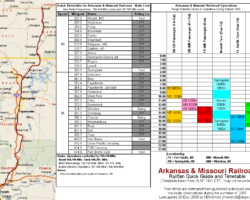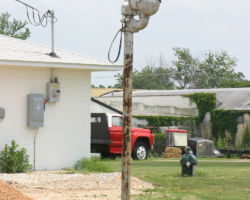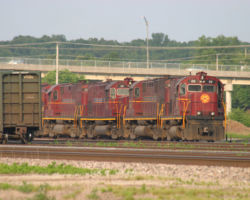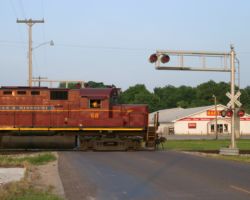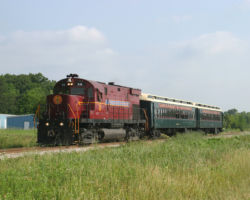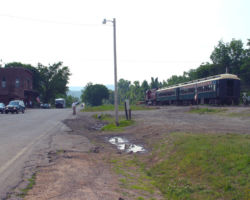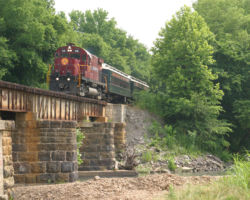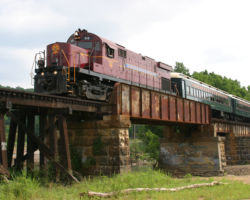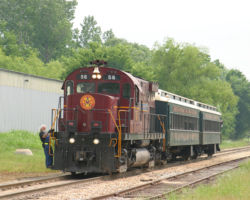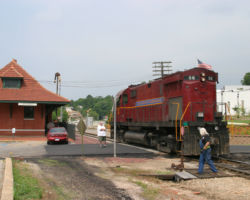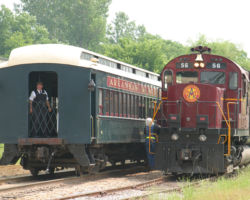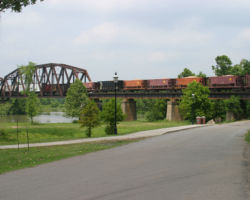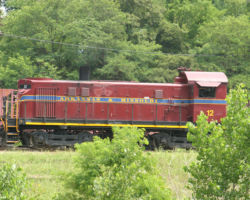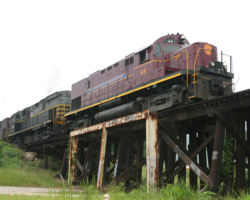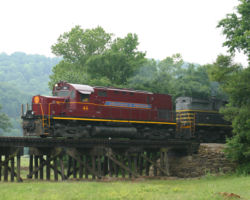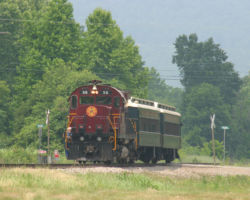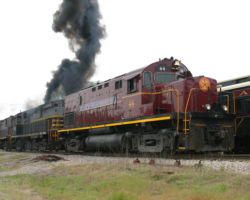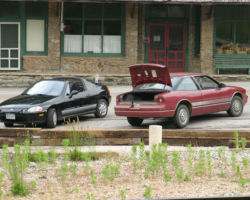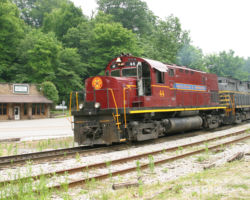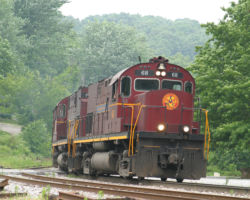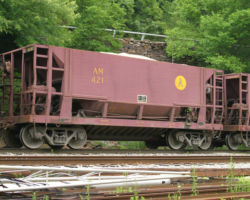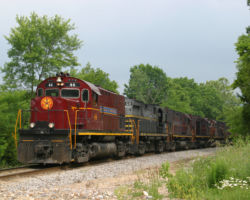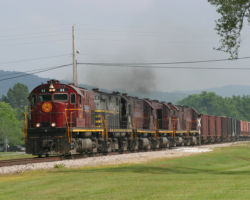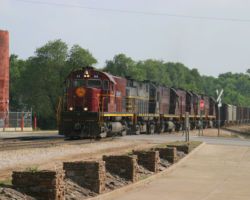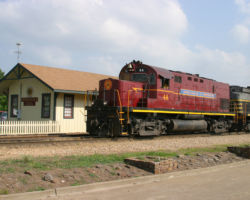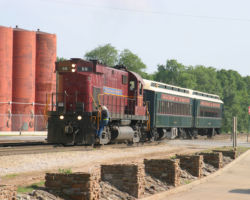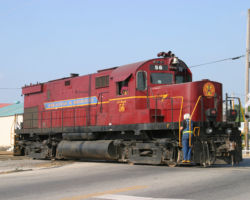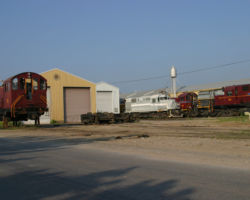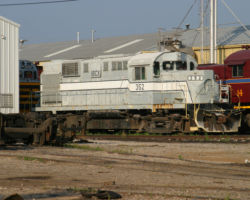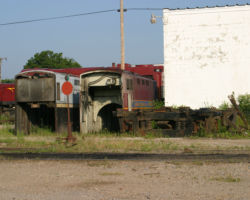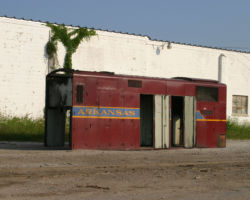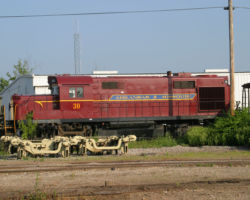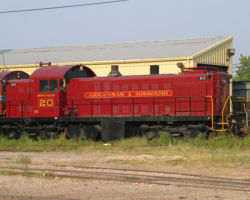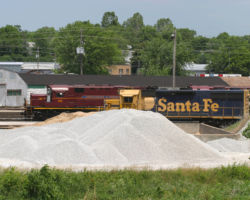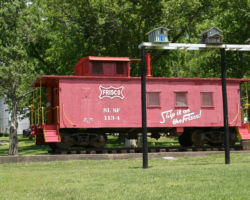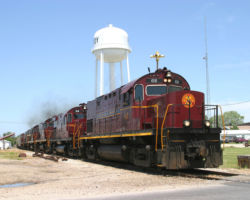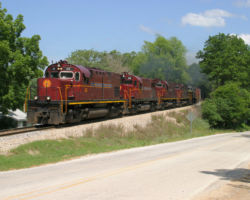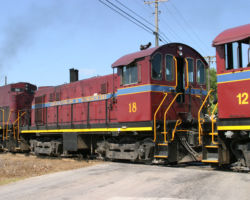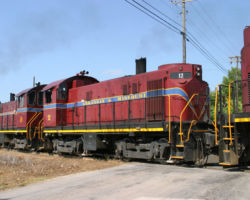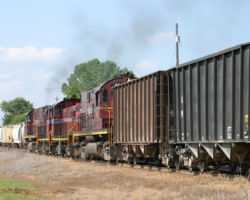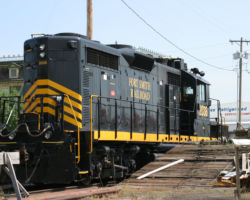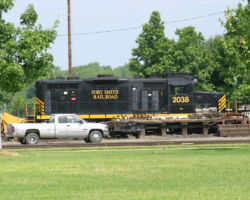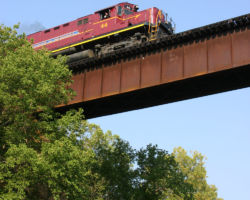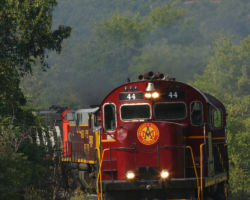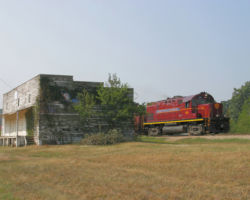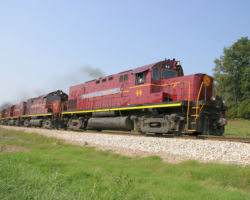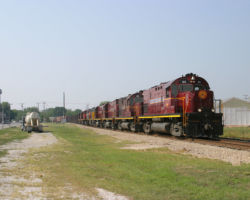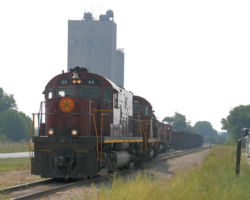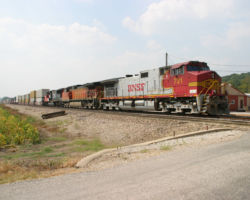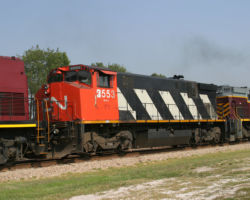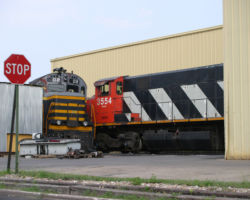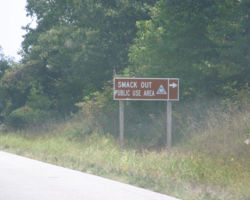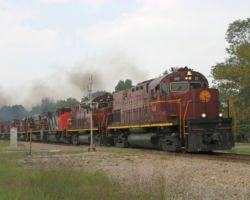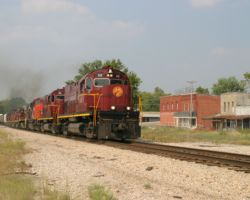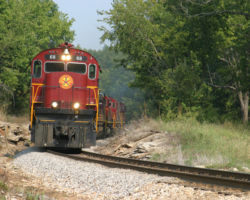The Monett Turn – Friday, Jun 3, 2005
Despite my love of Alcos, one place I’d never managed to make it was the Arkansas & Missouri, a hidden haven of American Locomotive power in the hills of southern Missouri and northern Arkansas. During two of my routine trips to Memphis (June and September 2005), I decided to drive rather than fly. Not only would I get the chance to avoid the hassle of flying, but I’d also arrange it so I had time to stop by the A&M for a few days.
What today is the A&M started out years ago as the Saint Louis and San Francisco Railway’s Central Division, Ft. Smith Subdivision. The route was built between 1880 and 1882, taking some amount of time to build through the Boston Mountains on the southern half of the system. Of course, the Saint Louis and San Francisco Railway is better known as the SLSF, or simply the Frisco, and became part of Burlington Northern on 21-Nov-1980. The 140 mile route was sold by BN to the A&M on 1-Sep-1986. Since then, the railroad has operated with a pure Alco roster, with the mainstay being the fleet of C-420s. Also included are RS1s, RS36s, C424s, rare T-6s, and most recently, a few MLW M420Ws.
The northern half of the route runs through rolling hills, with no tremendously spectacular features. However, since the heaviest tonnage runs runs over this part and runs against the prevailing grade, trains out of Monett require a great deal of power. I’ve seen as many as eight Alcos straining to lift 10,000 tons of train out of Monett. Generally speaking, Missouri Hwy 37 follows the line between Monett and Gateway, where it joins with US 62 for the trip on into Springdale. Between Butterfield, MO, and Washburn, MO, the line gets well away from the road. You’re welcome to explore this stretch, but if you’re chasing, just skip it and use the greater speeds of Missouri 37 to your advantage. Trains across the north end usually are right on track speed – 49 mph – over this well-constructed route.
The south end of the system stretches from the shops at Springdale, AR, through Fayetteville, up and over the Boston Mountains, and finally into Van Buren and Ft. Smith, AR. In terms of scenery, this section is as different from the north end as night is from day. The Boston Mountains, while pale in comparison with the Rockies, are by far the most rugged, and arguably the most scenic, section of the Ozarks. The line crests inside a 1,780-foot long summit tunnel just south of Winslow, AR. As the A&M descends from the summit, it passes over several deep valleys, spanned by three spectacular (but nearly inaccessible) steel trestles, each better than 150 feet in height. Rail traffic is slower in these parts, limited to about 35 mph. To make things even more interesting, heavy northbounds will double the hill between Schaburg and the Winslow summit from time to time. As far as passenger trains go, it seems that most of the meets involve the very short siding at Chester.
For the fan on the south end, the best choice of routes US 71, which roughly parallels the line between just south of Fayetteville and Mountainsburg. Between Exeter and Chester, the line is largely off in the mountain valleys, away from any road. Unfortunately, this is also where the spectacular trestles are located… Exeter and Chester both require short drives (1-2 miles) off of US 71, but both are photogenic (and operationally important) Ozark towns and shouldn’t be missed. South of Mountainsburg, you can use Arkansas 282 to access the tracks for another few miles, passing under a very strange bridge. Beyond that, the rails again get away from the road, aside from some sporadic grade crossings, until Van Buren. Van Buren is both the interchange with the Union Pacific and the site of the railroad’s Arkansas River Bridge, complete with lift span. The bridge area is easy to access on account of a riverside park south of the bridge’s east end. Once over the bridge, the line extends a few more miles into the Ft. Smith yard, interchanging with the KCS’s branchline and the Ft. Smith Railroad, a Pioneer Railcorp shortline.
Note: If you’re a driving nut like me, US 71 from Exeter to Mountainsburg is an incredible section of road. Twisty, winding mountaintop running, with spectacular vistas off to the east side. Find a nice day, load up the convertable, and get out there and burn some asphalt. I-540, the recently completed (1999) freeway through the Boston Mountains, is impressive in its own right, but not nearly as much fun to drive as the old road.
Operations are centered around Springdale, AR, where the road’s main shops are located. Two main trains ply the system – the Monett Turn, running from Springdale up to Monett, MO, and the Ft. Smith Turn, running south from Springdale to Ft. Smith, AR. The Monett Turn services a few online customers (the largest of which being a sand pit just south of Monett), but largely exists to interchange with BNSF at Monett. Since there are almost no online customers in the mountainous stretch south of Fayetteville, AR, the Ft. Smith Turn makes a run straight through to Van Buren, where it interchanges with UP, and then a few miles further into the Ft. Smith Yard, connecting with the Ft. Smith Railroad and the Kansas City Southern. Also included in this mix are a few switchers, including one that services the Ft. Smith-Van Buren area and one that services local industries around the Springdale-Bentonville region.
During the summer the mix changes a bit, with the addition of three regular passenger trains and occasional specials. The first is a Friday-Saturday train that runs from Springdale down to Van Buren and back. While the passengers lay over in Van Buren, the equipment is reutilized to make a short mid-day run from Van Buren up to Winslow and back. Upon arrival back in Van Buren, the original passengers are reboarded and hauled back to Springdale. The other train, which runs only on Sundays, takes sightseers over the mountainous section of the line from Ft. Smith up to Winslow and back.
My best advice to anybody fanning the A&M is to be absolutely sure you have the FRED frequencies (452.9375 MHz and 457.9375 MHz) plugged in your scanner as priority channels (if your scanner supports such things). The A&M is a very quiet railroad, only infrequently using the radio. More often than not, I knew a train was nearby because I started hearing FRED blips. The only time trains would really announce themselves was when two were operating within close proximity, or the dispatcher was wanting an update. Also note that the A&M runs two radio repeaters – Exter and Winslow. Monitor 451.400 MHz and 456.400 MHz to pick up repeated transmissions between the Exeter/Winslow bases and the dispatcher. Also, once you have a train, plan ahead and time things conservatively. Because they’re often out of sight, it’s very easy to lose one while trying to figure out which side roads will yield the best shot. Don’t ask how I know, let’s just say this trip report would have more photos if I’d done a better job of taking my own advice. So, without further blabbering, let’s finally get to the trip…
The first A&M trip started in the early morning hours of Friday, 3-Jun-2005, from Coffeyville, KS. Now, you’re thinking that Coffeyville isn’t on the A&M, and you’d be correct. However, it is a major operational hub for the various Watco lines in Kansas, and has an impressive collection of rare (but dead) units, including a Katy RS3m. More on Watco’s Coffeyville junkpile later in Chapter 13… Regardless, after getting my morning shots, I headed on east to Monett, MO, to begin backtracking in search of the Monett Turn.
My intention was to meet the Monett Turn somewhere out on the line. Now knowing just how hard it is to find a train on the A&M if you’re not quiet sure of its position, this was a stupid, stupid way to start things off. I drove the entire line from Monett down to Rogers, AR, and didn’t find a stinkin’ thing. I was growing quite concerned that I’d missed the Turn, until I saw five big maroon Alcos idling just north of the Bentonville Branch junction. This threw up all sorts of questions, such as if my schedule estimations were way, way off and I was going to have to rethink things. After all, according to what I knew, there was no reason that the Monett Turn should still be at Bentonville Jct. at nearly noon. As things turn out, it was just a particularly late, and weird, day.
As I got turned around and found a grade crossing, they had pulled forward to switch a single car into a customer alongside US 62 between Rogers and Avoca. The train was headed up with a solid set of C-420s – 44, 58, 48, 66, and 68. Despite being only noon, the oppressive heat of the day was already on us. It’s not really that it was all that hot – only about 84 – but at nearly 90% humidity, downright sweltering. The crew backed onto the rest of the train (Photo #2) and, without much delay, notched out the Alcos for the climb north.
Remember what I said about not underestimating trains on the A&M? Well, here’s a perfect example. North of Avoca, there’s a great high bridge over a small stream. It’s accessed by a road going east of the main highway called Sugar Creek Road. I thought I could beat the train down there from Avoca, so I went and sat… and sat. I thought maybe they’d stopped to switch another customer. (FYI – there aren’t any more between the two points…) Turns out that the Turn had completely smoked me to the bridge, and was still headed north while I sat and looked like an idiot. Once I realized the error of my ways, I tore out of there and back onto the highway. Fortunately, the train had stopped to switch log cars at Gateway (near the AR/MO border), and thus by Seligman, MO I was once again ahead of it. (Photo #3) With the sun nearly at its highest point in the sky, it was a lousy shot, but out of fear of getting skunked, I presesd the shutter anyway. It’s not the greatest, but it’s passable.
I tried to beat the train to Exeter, but failed miserably. The trip back from Exeter to the main road cost me so much time that my only option was to run clear up to Purdy, one town before Monett. Purdy has a unique grade crossing – it’s unprotected, just crossbucks, but it has an unusual Union Switch & Signal “teardrop” bell on a pole by the crossing that does go off when a train approaches. (Photo #5).
Between Purdy and Monett lies a siding that serves Kay Concrete. This out of sight, out of mind siding can keep a train crew busy for quiet some time and make it appear that a black hole ate the train you were following. It’s also the directly related to all that sand you see moving around the A&M system. I’ve never seen a Monett Turn not switch this facility… In fact, sometimes on days when the Monett Turn doesn’t run (usually Saturday), Sand Extras are run specifically to keep this customer serviced. Once they finish this facility, they start down the hill to the BNSF interchange yard at Monett, MO. (Photo #6)
Usually the Monett Turn arrives, does its work in an hour or two, and immediately heads for home (Springdale, AR). On this day, probably because it was running so late, the crew died at Monett. Thus, the crew tied the train down after completing most of the yard work. (Photo #7) I waited and waited and waited some more, and finally, just as the sun was starting to kiss the horizon, a fresh crew showed up and started the train back towards Springdale. In the very last light of the day, I grabbed shots of AM 68 leading out of the BNSF interchange yard (Photo #8) and then a profile shot of it crossing County Road in Monett.
Overall, it hadn’t been the greatest day, but I had gotten familiar enough with the north end that hopefully I wouldn’t botch it again. With the sun being gone, I grabbed dinner and headed for the hotel in Bentonville. Hopefully Saturday would go a bit smoother.
Saturday Morning – Jun 4, 2005
After Friday’s screwups, I went back to the hotel and poured over the topo maps and any information on the web relating to the A&M south of Springdale. I wasn’t quite as worried, since the south end has far less online industry and the freight is supposed to run late in the day or at night. I was mainly out after nice scheduled, predictable passenger trains. The first one would head south out of the Springdale depot at 0800h and go all the way down to Van Buren in two-and-a-half hours. The plan was to follow it, and then chase the Van Buren-Winslow passenger turn up to Winslow and back, and then follow the original passenger train’s return run back to Springdale.
The morning started off as planned, at least. I showed up a bit early, photographing bits of the Alco fleet that could be seen from public property around the Springdale facilities. You’ll get to see more of that in Chapter 4 (Misc A&M photos). However, the scheduled passenger train was there and ready to go, lead by AM 56. 56 is a C-420 that started off life as Lehigh & Hudson River 25, eventually winding up as BC Rail (BCOL) 631. From the far north, it was purchased by the A&M and reunited with L&HR siblings 22 (now AM 50), L&HR 23 (now AM 52), L&HR 24 (now AM 54), and L&HR 29 (now AM 58). 56 is named JA Hannold, after the former president of the Arkansas & Missouri J. Anthony Hannold (RS-1 #22 used to hold the name, but sometime after 56 was acquired, the name transferred). Behind 56 on this hazy June morning were two very well-kept heavyweight passenger cars – AM 106, the Mountain View, and AM 105, the Golden Age.
I set up the first shot on South Ball Street, a backroad running between Johnson, AR, and Fayetteville. This lightly-travelled road follows the tracks south from Johnson and crosses a small river. Near the first grade crossing, I set up and waited about five minutes for 56 and train to arrive (Photo #11). Having driven through Fayetteville the night before, I decided to skip around town and set up again on the south side, where US 71 rejoins the tracks for the trip southward. Thanks to I-540, that’s easy. Otherwise, following a train through Fayetteville would almost certainly be a receipe for disaster – travel through town is just too dang slow.
South of Fayetteville are two small towns before you launch out into the mountains – Greenland and West Fork. Neither provides an outstanding photo opportunity, but having no experience with the line, I decided to try them both. Greenland was easy – the railroad runs pretty much right along US 71. (Photo #12) West Fork requires you to leave the main highway and go downtown. It’s a typical southern small town – there’s a large park-like area running down the center with old buildings on one side, marking where a small but booming downtown once existed. The railway bisects the large grassy field in the middle. Today there’s not even so much as a siding there. However, I got a kick out of Photo #13 – 56 is passing one of the old buildings, which is now in use as the “Little O Oprey House”. At least it’s in use as something – it’s a really nifty old building, and I’d hate to see it falling apart. Too many towns like this have just let their historical buildings crumble, whereas West Fork looks relatively well-kept, if not terribly lively.
South of West Fork, the line follows the Upper White River as flows downhill from near Winslow. The only problem is that US 71 is on the east side of the river and the A&M tracks are on the west. Few roads cross over, and even if you can get to the west side, the line runs through a canyon of green foliage, making morning shots tough and contrasty. Still, I figured it was worth a shot, and I snagged our train again at MP 370 – Brentwood – off something called, appropriately enough, Brentwood Mountain Road. After that, it was on into Winslow, highest point on the A&M’s southern half.
Winslow was a colossal failure. I didn’t have enough time on the train and the lighting was all screwed up. Because of how Winslow is situated in the mountains, it wasn’t even getting daylight yet. While I was desperately trying to sort out lighting and angles (and find something different than the wedgies I’d been shooting all day so far), the passenger train slipped right on by. Oh well, on towards Chester.
Like I mentioned earlier, between Winslow and Chester is the most mountainous part of the line. It’s also the least accessible, with US 71 crossing over the mountains several miles to the east. So, in running around the hill, I wasn’t entirely sure I’d beat the train into Chester. I figured it was worth a shot, and thankfully on the way in to town on the other side, I heard some chatter on the radio confirming that I had beat the passenger train in. There was some mention of a freight train, which confused me, but I disregarded it as something I’d mis-heard.
I think I sat there, stunned a little bit, until 56’s horn brought me back from my stupor. At the last moment, the sun went behind one of the growing clouds in the sky. Consequently, my shot of the morning passenger train along Chester’s interesting main street didn’t come off well at all. Still, I like it enough to include it as Photo #15. It’s the only shot that really shows downtown Chester at all.
Beyond Chester is the town of Mountainburg, where US 71 starts to bend away from the railroad. Fortunately, a little road called 282 follows the line for a few more miles, including past one really cool bridge near Lancaster, AR (just south of Mountainburg and on the west side of I-540). Here in Photo #16 we see the train about to step out onto the bridge, followed by #17, a wider shot of the bridge, including the trestle portion, which the road passes underneath.
Despite starting to rain a bit, I followed this 282 road on around to Rudy, the next major grade crossing. That was pretty much another bust in terms of light, so from there, it was a bee-line for the Van Buren station so that I could watch the train come in. (Photo #19) Before actually pulling in, they used the Van Buren siding to run around the train. That way, once they had unloaded the morning passengers, they could pick up the batch that would be riding between Van Buren and Winslow for the mid-day train. (Photos #20-21) Also note in Photo #19 that, in addition to the train order semaphore at the station, there’s a real, fixed semaphore as a distant signal for the UP interlocking about a mile away.
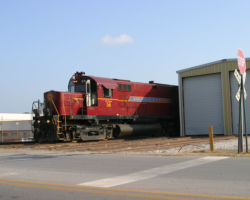
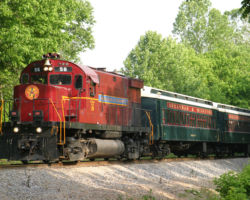
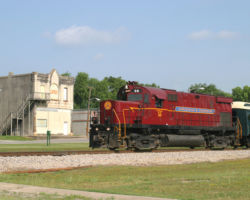
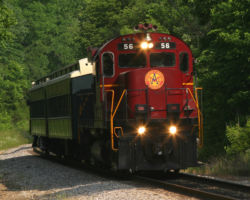
Saturday Afternoon – Jun 4, 2005
After having watched the train arrive, I headed over across the Arkansas River to Ft. Smith. The reasons for this were threefold – my bladder had been screaming at me for about thirty minutes, my stomach was demanding lunch since I’d skipped breakfast, and the Sol was about half down on gas. Once grabbing lunch and gas, I found something surprising – a Ft. Smith Turn, all set up and ready to head north, parked about a half mile short of the bridge. (Photo #22) Apparently the freight I’d heard discussed earlier was a Ft. Smith turn running far ahead of the passenger train.
With the sudden realization that the train was just waiting for the bridge, I jumped back in the car and busted my rear over to Meyer Park, along the riverfront in Van Buren. From this park, a decent shot of trains coming across the river bridge can be had. Due to a wrong turn and some severely uncooperative traffic lights, I missed it anyway. By the time I was in position at the park, the head end had already crossed the bridge. Still, Photo #23 will give you some idea of the view possible from here. In addition, the UP line and UP-A&M interchange tracks are relatively close by, so it’s often possible to see the Ft. Smith / Van Buren switch job shoving cars around. On Saturday, that job had one of the unusual Alco T-6 units in the consist – #12 (Photo #24).
My plan for Saturday had been to chase the passenger trains around, but the opportunity to follow a freight train on the south end was far too good to pass up. Plus, the light was failing, and it was looking lighter up to the north, even with the heavy haze. So, I hit the freeway, taking I-540 up to Mountainburg, intending to double back and catch the freight at that bridge I’d visited earlier. It worked out pretty well, really. I arrived about five minutes ahead of the train. This worked out quite well, as it allowed me to warn a couple people that were sitting on the bridge and fishing that they might want to move in the next minute or two, lest they be forced to jump at an inconvenient moment. They thanked me for the heads up and wandered off the other end of the bridge, disappearing back into the woods. Almost as soon as they were out of sight, the clatter and rumble of six Alcos battling the grade could be heard in the distance. Within 30 seconds, this almost unholy thunder was crossing the bridge above me (Photo #25). There’s one thing about Alcos – you *know* when they’re working, and it’s an unforgettable sound.
While the train was passing by overhead, I felt it. First a single drop, followed by a friend, followed shortly by a whole mob of the little wet buggers. Not wanting to waste time, as I had the next shot all planned out in my head, I jumped in the car and took off like a shot, ignoring the rain soaking my seats and my clothes. After all, if you go fast enough, the air streaming over the windshield prevents it from dropping in the passenger compartment, right? Plus, the train was making good time, and I’d need a little speed and a little luck to make the next location. Just out of Mountainburg, a few hundred yards south of the connector out to the freeway, lies an old, low trestle across some swampy drainage ground. I’d seen it on the way in from 540, and thought it would make an ideal shot with the diffuse light. With the addition of rain and clouds, there almost wasn’t enough light to make it work with a relatively fast train, but I managed to grab the shot I wanted as Photo #26.
There was one thing I hadn’t quite considered – there was still a passenger train somewhere between my present location and the summit at Winslow, AR. While I’d forgotten this fact, thankfully the dispatcher had not. Over the radio came the details of things to come – 44 and the northbound freight would stop at Chester to meet the southbound 56 and passenger train. (Photo #27) With plenty of time before 56’s arrival, one of the crew stepped off to go over to the local store and pick up some drinks for the long, hot trip up the hill. About twenty minutes later, accompanied by a brief break in the clouds, 56 and train appeared at the other end of town. (Photo #28) The crew opened the north switch, let the passenger train in, and then lined and locked it again for the main so they could head out (Photo #29).
The surprising thing about the A&M’s Alcos is that they usually run pretty clean. They received exceptional maintenance and improvements under the Hannold regime at the A&M, and should be good for a great many more years with appropriate care. The two ex-Belt Railway of Chicago junker C-424s, A&M 01 (ex-BRC 601) and A&M 02 (ex-BRC 602), however, do not run cleanly. Both of these give the good ol’ Alco smoke belch on startup, as well as leak smoke and oily soot from every crack in the carbody. It may not be good for the machine, but it’s their most memorable quality from a trackside perspective. Every time, you ask yourself, “Is it just working hard, or is it on fire… or both?” (Photo #30)
With the freight on its way up the hill, 56’s crew backed the southbound passenger out onto the mainline for the remainder of the trip south. (Photo #31) I even gave a brief thought to following it down to my two favorite bridges, but decided to continue pursuing the freight instead for obvious reasons. Having no idea how to access the line between Chester and Winslow, I figured I’d just drive around to the other side of the summit and wait in Winslow.
Turns out it was a decent wait at Winslow – nearly an hour went by between when I left Chester and when 44 came around the curve out of the tunnel. Not that that time was necessarily wasted. I dumped the photos off the camera, cleaned up the inside of the car, and caught up with CNN via satellite radio. While sitting there, I noticed that a man and his daughter asking some of the locals about a tire iron, so I figured I’d see what was going on. Turns out his Olds had a slow-leaking flat, and he needed to get it changed before driving any further (down to Van Buren to get it fixed). Unfortunately, he didn’t have the right tool… Fortunately for him, I always carry an air compressor, and since it was a slow leak, he could even skip changing the tire out for a spare. Also, for that matter, it’s a good thing my lighter plug worked, since his didn’t. Unfortunately, that meant no scanner for me, since it was drawing off car power to run. Oh well, I didn’t need the scanner anyway.(Photo #32)
Since I didn’t have the scanner, I was caught completely by surprise when 44 came out of the bore and through downtown Winslow. (Photo #33) I wasn’t so much caught off-gaurd by the train, as I could hear the Alco motors barking a mile away, but rather by the fact that the only things trailing them were sand cars. The rest of the train was, well, missing. It was only then that the obvious hit me – they’d doubled the hill due to tonnage. The rest of the train was still sitting down at Schaberg, and they’d be going back for it shortly.
As for the rest of Saturday, basically it involved waiting another hour in Winslow for them to drag the rest of the Ft. Smith turn up the hill, and then following it back to Springdale. Really it was quite uneventful, but the sun did eventually come out, yielding some decent shots.
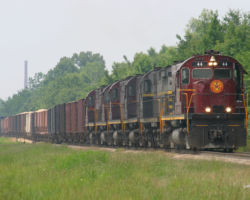
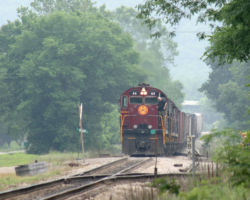
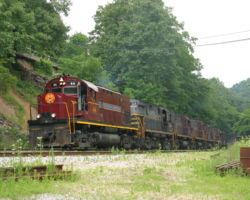
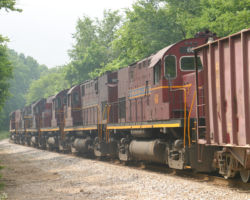
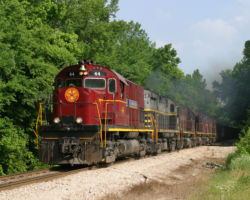
A&M Miscellany
I had some left-over A&M material that didn’t really fit in the storyline, but was otherwise interesting. I’ve just included it here.
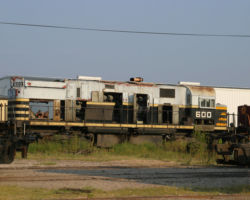
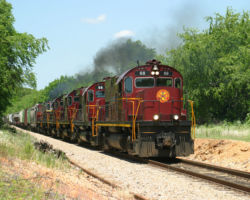
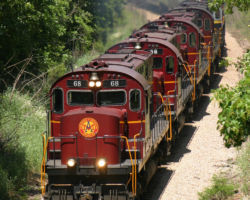
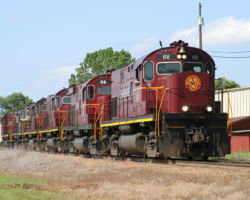
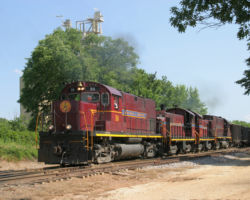
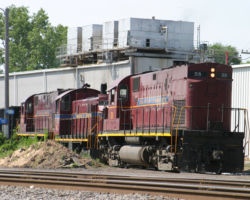
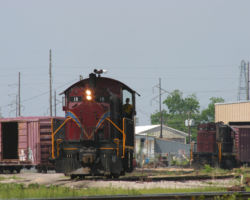
The A&M Monett Turn Revisited – Sep 11, 2005
In mid-September, once again I had to travel to Memphis. Since the weather looked nice I figured I’d take another pass through A&M country to see if I could catch another Monett Turn. Sure enough… Now that I knew the country a bit better, it gave me a chance to redeem myself for my first attempt a few months earlier.
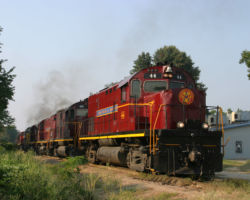
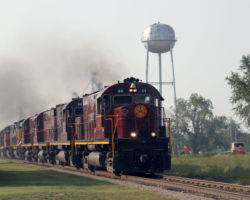
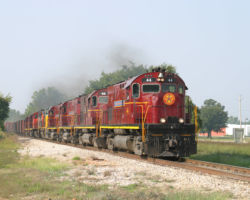
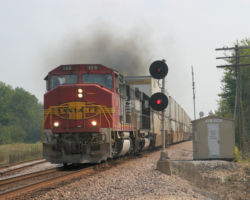
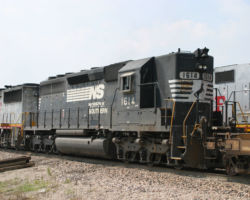
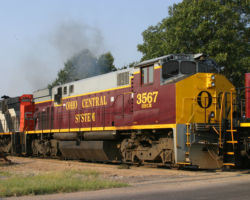
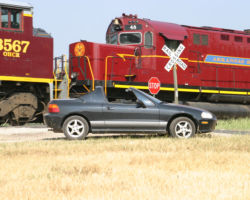
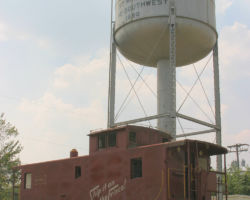
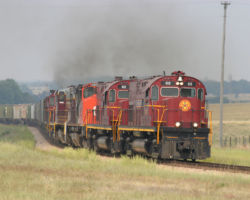
All photographs in this trip report were taken with a Canon EOS 10D using either a Canon 28-105mm USM or a Canon 75-300mm f4-5.3 IS/USM.
This work is copyright 2024 by Nathan D. Holmes, but all text and images are licensed and reusable under a Creative Commons Attribution-NonCommercial-ShareAlike license. Basically you’re welcome to use any of this as long as it’s not for commercial purposes, you credit me as the source, and you share any derivative works under the same license. I’d encourage others to consider similar licenses for their works.
